The Cambrian Explosion
Biologists classify organisms into various groups. In this systematic classification, known as taxonomy, hierarchical categories are set out according to the various characteristics of organisms.
The Systematics of Organisms
Under this system, life forms are first classified as kingdoms. They are then divided into phyla, which in turn are divided into other sub-categories. The hierarchical classification runs like this;
-
Kingdom
-
Phylum (plural phyla)
-
Class
-
Order
-
Family
-
Genus (plural genera)
-
Species

Genes cannot turn into still-functioning genes by undergoing mutation. Nor can they give rise to completely different organs or limbs, such as a wing in place of an arm, by such changes. The probability of an internal characteristic emerging spontaneously in an organism is the same as throwing a die 1,000 times and it coming up 6 every time—in other words, 1 in 1 quintillion. In mathematical terms, such a probability is zero.
Scientists divide the animal world into five kingdoms,—which number has recently varied between six and three, depending on different classifications—and then divide these into 25 to 35 phyla. The factors determining phyla are rather basic, including such details as the number and kinds of organs and tissues, body symmetry and the presence and nature of bodily cavities.41Accordingly, you can see that the factors determining phyla are based more upon internal organization than external features. For example, the elongated shape of an earthworm is a feature shared by several phyla. Yet although different creatures share a similar worm-like appearance, because their internal structures are completely different they are viewed as independent species belonging to entirely different phyla. Internal organization involves such things as the exchange of gasses like oxygen and carbon dioxide inside the tissues, food absorption and how reproduction takes place. The largest phylum is that of shelled organisms. The 35 or so animal phyla include such diverse phyla as the Mollusca which contains some soft-bodied creatures, and the Nemotada, which includes roundworms.Arthropods, for instance, (insects, spiders and other invertebrates with stiff exoskeletons) represent a completely separate phylum. Chordata, on the other hand, includes creatures with a notochord—a long rod in the embryo consisting of a string of cells that will constitute the creature’s spinal cord—or more often, a spinal column. All vertebrates, such as birds, fish, reptiles and mammals, belong to this phylum. Mollusca is a separate phylum, including clams, oysters and slugs. Annelids are yet another phylum, to which earthworms belong.
The internal organization determining the phyla is controlled by a large number of genes. This means that in order for evolution to take place in such a way as for one organism to develop into another and for two distinct phyla to emerge, all the details of the first organism’s internal structure need to change. To accomplish that, all its genes would have to undergo mutations at the same time. Each of these random mutations would also have to be beneficial. Such an accumulation of changes is scientifically impossible.
Mutations are 99% harmful. The other 1% have no effect at all. The internal characteristics of even the smallest organisms are too complex to come about in stages. Genes cannot change in such a way as to serve new functions, and cannot transform into different genes that give rise to new properties. In the same way, the genetics of any organism are very little influenced by external factors. It is impossible for two organisms to develop a similar, common internal characteristic under the pressure of external factors dependent on various conditions. The probability of this happening is the same as that of rolling a thousand dice and their all landing on a 6—in other words, 1 in 1,000,000,000,000,000,000, or 1 in a quintillion.42(For details, see Darwinism Refuted by Harun Yahya.)
What is a phylum?
The phylum is the largest taxonomic category ranked below kingdom. Chordata, which includes vertebrates, Arthropoda, which includes insects, and Mollusca, which includes all soft shelled animals, are among the best known phyla. All animals in these phyla have body plans unique to them. Phyla are also divided into various sub-groups. In decreasing order of size, the hierarchical classification in question runs:
kingdom > phylum > class > order > family > genus > species
This information has been provided to demonstrate, in general terms, how life forms differ from one another. Living things cannot acquire an organ that did not previously exist by way of random factors. This applies even to the smallest taxonomical unit: One species cannot turn into another; this is impossible. And the variety of life that emerged in the Cambrian gave rise to different phyla more than simply new species!
Fifty separate phyla, including the 35 alive today, emerged suddenly in the Cambrian Period. Among the great many details regarding the Cambrian that evolutionists cannot account for, the sudden emergence of phyla exhibiting hundreds, perhaps even many more, of different anatomical features and characteristics—plus the fact that there were more of these phyla than exist today—is a phenomenon that evolutionists cannot possibly explain. The fossil record makes abundantly clear that the theory of evolution cannot be valid.
The famous French zoologist Pierre Grassé has this to say:
Naturalists must remember that the process of evolution is revealed only through fossil forms. . . . Only paleontology [the study of fossils] can provide them with the evidence of evolution and reveal its course or mechanisms.43
The truth paleontology reveals is that evolution has no place in natural history. During the Cambrian explosion, the main living groups began suddenly and with flawless bodily structures. Despite evolutionists’ best endeavors, no intermediate form between them has ever been found, and paleontology has undermined the tenets of Darwinism. This process of collapse began with an unpublicized discovery made in Canada in 1909.
Burgess Shale Fauna: Discovery of A Miracle
The differences between the creatures that suddenly appear in the Cambrian are enormous. In fact these differences are so large many of these animals are one of a kind. Nothing like them existed before and nothing like them has ever appeared again.44
Charles Doolittle Walcott was a paleontologist and the secretary (1907-1927) of the Smithsonian Institution, America’s national museum. He learned that railway workers in the Burgess region near the Canadian Rocky Mountains had discovered a number of fossils, and made visits to the area to see for himself and look for specimens of the fossils in question, beginning in July 1907.
On 31 August, 1909, this experienced paleontologist paid yet another research visit to Burgess. But this day was very different: At the beginning, the investigation he carried on that day appeared to be a very ordinary one. But it turned out to be one of the greatest discoveries in the history of paleontology.
The bedrock in Burgess Shale consists of schist—a rock consisting of thin strata, or layers. When struck at the appropriate angles, the rock can be easily split into thin plates, thus revealing the fossils inside them. Thus on that day, Walcott came by the first Cambrian fossil in Burgess Shale. He marked the location of the fossil in order to begin a detailed investigation later on. Upon resuming his research, he obtained findings that were invaluable in paleontological terms.
| It is He Who created the heavens and the Earth with truth. The day He says “Be!,” it is. His speech is Truth. The Kingdom will be His on the Day the Trumpet is blown, the Knower of the Unseen and the Visible. He is the All-Wise, the All-Aware. (Surat al-An‘am, 73) |
In the course of the investigations he carried out in those years, Walcott discovered the remains of certain soft-bodied organisms that at first sight appeared very mysterious. He tried to identify them and to understand why he had found them there, since according to the state of knowledge at the time, no such fossils should have been present. Realizing that his findings were extraordinarily important, Walcott immediately set to studying the exceedingly well preserved specimens he had uncovered.
The oldest Cambrian strata contained animal fossils that displayed a magnificent variety and complexity, opening a window onto a period hundreds of millions of years in the past. Although these fossils belonged to soft-bodied organisms, they were exceptionally well preserved. The fossils enclosed between the very thin layers of rock were like miniature X-rays, revealing details of even their soft tissues. He found fossils belonging to various known groups, of marine creatures, most of them soft-bodied, including brachiopods, worms and arthropods.
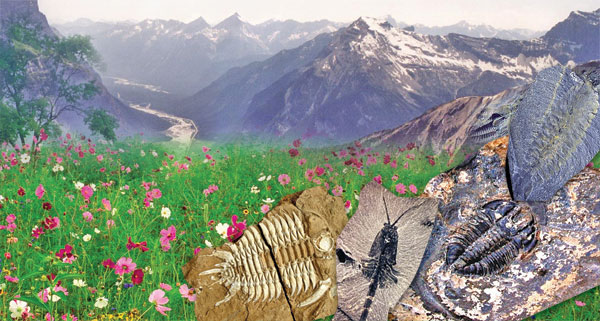
Canadian Rockies
But what were fossils of creatures that had lived on the sea bed hundreds of millions of years ago doing some 3,000 meters (9,850 feet) high in the Rocky Mountains? It appeared that these creatures had been covered over in sand as the result of an underwater slide that had occurred hundreds of millions of years ago, and that this sediment-containing strata had risen up under the influence of geological pressures to form the Rocky Mountains. This made it possible for exceedingly well-preserved fossils of the ancient, yet complex living things to be to Walcott’s gaze.
Inspired by the nearby Mount Burgess, Walcott named the region “Burgess Shale” and collected some 65,000 fossil specimens there between 1910 and 1917.45
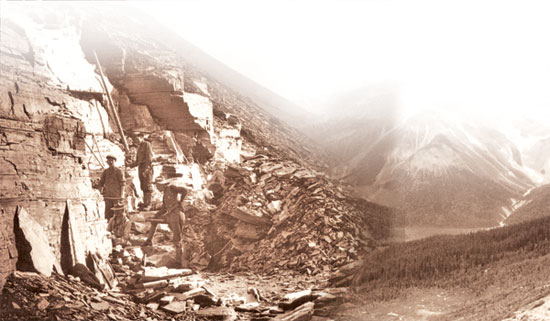
Charles Doolittle Walcott, who collected some 65,000 specimens of the earliest complex life forms in the Burgess Shale region, was responsible for one of the worst scientific cover-ups in history. Since he realized that the fossils he discovered would substantially demolish the theory of evolution, he concealed them for 70 years in the Smithsonian Institution, of which he was the secretary. However, this still failed to hide the facts of the Cambrian Period. Newly discovered fossils in various parts of the world clearly showed that there had been an explosion of life in the Cambrian Period. The Burgess Shale fossils, which were brought out into the light after 70 years, also made this crystal-clear.
When he saw to which phyla these fossils belonged, Walcott was amazed. The fossil stratum he had discovered was very old, and no life forms worthy of note had been found in any older strata; yet this stratum contained organisms from almost all known phyla. Moreover, Walcott had discovered fossils belonging to unknown phyla as well. This showed that all the various body structures in the animal kingdom had appeared together during the same geological period.
This represented a lethal blow to Darwin’s theory, since Darwin had maintained that organisms must have developed as do the spreading branches of a tree. According to the tree of life Darwin had imagined, there must initially have been a single phylum on Earth, after which different phyla began to emerge or “branch off” from it over long periods of time. Yet Walcott was looking at evidence that demonstrated that over two dozen phyla had emerged together and suddenly. This meant a total refutation of the “evolutionary tree” idea. Phyla, represented by the most remote branches of the tree and which should have appeared last, after species had time to differentiate, actually emerged at the beginning of the history of life.
No doubt Walcott’s discovery was highly significant, yet it took another 70 years for the blow it had dealt to Darwinism to be revealed.

No matter how much evolutionist frauds like Walcott attempt to conceal them, the fossil record constantly reinforces the fact of Creation throughout the history of the Earth. Allah’s flawless creation is constantly exhibited in the fossil record. No matter how evolutionists strive to prove the opposite, their efforts will always be doomed to failure, as happened with Walcott’s.
Instead of making the fossils he had obtained available to the world of science, Walcott decided to hide them. He was then the secretary of the famous Smithsonian Institution in Washington D.C., and also a dyed-in-the-wool Darwinist. According to the theory of evolution, relatively simple fossils should be expected in rocks of that age. Yet in terms of anatomical complexity, there was no difference between the fossils Walcott discovered and present-day creatures such as crabs, starfish and worms. For Darwinists, the alarming aspect about this was that in older rocks, no fossils had been encountered that could possibly be the forerunners of the creatures in this Burgess Shale formation.
Faced by this dilemma, Walcott felt sure that the fossils he had discovered would represent a major difficulty for the theory of evolution. So instead of announcing them, he sent them to the Smithsonian Institution, along with a few photographs he had taken and a series of notes.
The Burgess Shale fossils were locked away in drawers and forgotten for the next 70 years. They saw the light of day only in 1985, when the museum’s archives were being re-examined. The Israeli scientist Gerald Schroeder comments:
Had Walcott wanted, he could have hired a phalanx of graduate students to work on the fossils. But he chose not to rock the boat of evolution. Today fossil representatives of the Cambrian era have been found in China, Africa, the British Isles, Sweden, Greenland. The explosion [in the Cambrian Period] was worldwide. But before it became proper to discuss the extraordinary nature of the explosion, the data were simply not reported.46
Decades after Walcott’s death, the Burgess Shale fossils were re-examined. Harry Blackmore Whittington, Derek Briggs and Simon Conway-Morris, a team of scientists known as the Cambridge Group, performed a detailed analysis of the fossils in the 1980s. They concluded that the fauna were even more varied and extraordinary than Walcott had stated, and reported that the fossils could not be classified under any known categories. All these organisms had emerged suddenly in the Cambrian Period, between 542 and 490 million years ago, in their exceedingly developed and complex forms.
The results that emerged were so unexpected that scientists referred to their sudden appearance as an “explosion.” The Cambrian explosion was one of the most remarkable phenomena in the history of science, and for evolutionist scientists, one of the most inexplicable. Even Darwin, aware of the Cambrian findings from his own time, admitted that there would be doubts as to the validity of his theory until this significant phenomenon could be accounted for.47
Thus it was that the scientific world’s knowledge of the Burgess Shale fossils was delayed. These very well preserved fossils were like opening a window onto pre-Cambrian ecosystems of hundreds of millions of years ago. Scientists therefore became ever more interested in what they might reveal. The unearthing of new Cambrian fossil zones in the 1980s further increased scientific interest in the Cambrian explosion. These new paleontological discoveries showed that the scope of the Cambrian explosion was even greater than had been imagined—which made matters even more difficult for evolutionists.
Ironically, Walcott’s concern had been completely justified. The flow of information about the Cambrian explosion had an explosive effect on Darwin’s theory. The greater our understanding of the Cambrian explosion, the clearer the hollowness of Darwin’s fundamental assumptions became.
So far, this book has examined the pre-Cambrian Period and its life forms. In the next part, we shall be examining the Cambrian, in which an even more dazzling variety of life appeared. For that purpose, we shall consider the course of biological diversity in the pre-Cambrian and later periods, to provide a general idea about the emergence of living categories. We shall then examine the Cambrian’s extraordinary complexity and see how these creatures’ superior systems and structures pose a major dilemma for evolutionists.
After the chapter on complexity, we will compare the facts revealed by the fossil record with the assumptions of Darwinism and see why Darwinism is now a bankrupt theory.
But at this point, we can summarize the emergence of phyla—the main categories of organisms:
-
For billions of years before the Cambrian, the Earth contained only single-celled organisms and a few multi-celled ones with no complex internal systems. The number of phyla constituted by these organisms was only three.
-
The many phyla alive during the Cambrian world appeared suddenly and with flawless physical systems in a space of a mere 5 to 10 millions years. At the end of the Cambrian, 50 phyla had emerged, and with one exception, all phyla had taken their places in the fossil record.
-
In terms of animals’ main bodily structures, stasis dominated the fossil record after the Cambrian. Contrary to Darwinist expectations, there was no increase in the numbers of phyla. And when some of those phyla became extinct, there was even a corresponding reduction in their numbers. For that reason, on the level of basic physical structures alone, the Cambrian is more biologically complex than the present.
The Cambrian Explosion: A Dazzling Variety of Life
The Cambrian is the oldest known period containing multi-celled organisms with very different and complex structures. The first rock strata belonging to this period were discovered in North Wales by the British geologist Adam Sedgwick in 1835. Inspired by the original Latin name for Wales, Cambria, Sedgwick named this period the Cambrian. According to dates published by the International Subcommission on Cambrian Stratigraphy in 2002, the Cambrian Period is regarded as having begun 545 million years ago and ended 490 million years ago. It is also sub-divided into three smaller periods, or epochs, the Early (542 to 513 million years ago), the Middle (513 to 501 million years ago) and the Late Cambrian (501 to 490 million years ago).48
What makes the period so important in terms of natural history is the explosive proliferation of new life forms that took place in the transition from the pre-Cambrian to the Early Cambrian. In terms of biological variety and complexity, so great is the difference between the pre-Cambrian and the Cambrian that this phenomenon is described as an explosion, a reference to the sudden coming into existence of living things—the world-wide appearance of complex organisms with no forerunners behind them.
The evolutionist writer Richard Monastersky describes this phenomenon, known in the literature as the “Biological Big Bang”:
Prior to the start of the Cambrian period 544 million years ago, animals had extremely simple bodies capable of limited motion. A zoo at the close of Precambrian time would have displayed a relatively mundane array of creatures related to jellyfish and coral; the star attractions would have been wormlike animals, which distinguished themselves with their ability to slither across the seafloor. At the beginning of the Cambrian, however, life took a sudden turn toward the complex. In a few million years—the equivalent of a geological instant—an ark’s worth of sophisticated body types filled the seas. This biological burst, dubbed the Cambrian explosion, produced the first skeletons and hard shells, antennae and legs, joints and jaws.49

The truly extraordinary fact is that all the anatomical variety in the animal kingdom emerged in a time frame of only 5 million years. By using the analogy of a book, if we compare the Earth’s 4.6-billion-year history to a thick volume of 920 pages, then the first 814 pages are almost completely blank. On the other hand, all the anatomical richness of the animal kingdom emerged suddenly in full color on page 815. The ever-increasing beauty in the subsequent pages is all based on the physical structures on this single page. All the organs such as the eye, leg and antenna, that fill the following pages were first portrayed, in flawless form, on this page. The diagram below demonstrates the biological richness that emerged in the Cambrian explosion, consisting of an instant. (The green band represents the complete history of life, and the section in orange represents the Cambrian.)
In this period there suddenly appeared some 50 separate phyla, including the 35 phyla existing today. This is most important, because all the features of today’s living things—and of even more extinct ones—first appeared quite suddenly around 530 million years ago. Formerly, it was claimed that 14 more small phyla emerged after the Cambrian. But based on the features they possessed, they were later included in the 35 phyla existing today.
This means that, contrary to Darwinist expectations, there has been no increase in the number of phyla between the Cambrian and the present—and that since some phyla have gone extinct, there has actually been a reduction.
Therefore, the Cambrian Period is more biologically complex than the present—in terms of the fundamental structures that determine phyla.
This conclusion faced by scientists is truly astonishing, because as we have already shown in some detail, organisms consisting of only soft tissues lived shortly before the Cambrian. At that time, all organisms constituted only three phyla. When we look a little further back, however, there was nothing on Earth apart from single-celled organisms. Yet the Cambrian is a period when completely new life forms, with complex anatomies and perfect internal and external features suddenly appeared.
In his book This Is Biology, the evolutionist Ernst Mayr describes the phenomenon this way:
There are indeed many phenomena in the history of life which suggest the actual existence of such an internal cohesion. How else can one explain the virtual explosion of different structural types at the end of the Precambrian and the Early Cambrian? Even in the utterly incomplete fossil record, one can distinguish at that time some 60 to 80 different morphotypes, compared with the 30 or so animal phyla now in existence. ... one might almost say experimentally, a high number of new types, some of which were not successful and became extinct, while the remaining ones, represented by the modern chordates, echinoderms, arthropods, and so on, became more and more inflexible. There has not been the production of a single major new body plan since the early Paleozoic. It seems as if the existing ones had “congealed”—that is, had acquired such a firm internal cohesion.50
In the framework of the basic anatomical designs of the Cambrian Period’s newly emerged forms, Stephen Jay Gould refers to the variety they exhibit:
The sweep of anatomical variety reached a maximum right after the initial diversification of multicellular animals. The later history of life proceeded by elimination, not expansion. The current earth may hold more species than ever before, but most are iterations upon a few basic anatomical designs. (Taxonomists have described more than a half million species of beetles, but nearly all are minimally altered Xeroxes of a single ground plan.) In fact, the probable increase in number of species through time merely underscores the puzzle and paradox. Compared with the Burgess seas, today’s oceans contain many more species based upon many fewer anatomical plans.51
The “elimination” to which Gould refers is the sudden appearance of phyla in the Cambrian and the gradual reduction in their numbers. This is a total contradiction of the theory of evolution’s claim that the number of phyla should increase as species increased.
To clarify this with an analogy: Wheeled vehicles, aircraft, and boats are the humans’ main means of transportation. Cars, tractors, hovercraft, and canoes are all subcategories of these. Over the years, there has been an increase in their number and variety. Yet the number of these basic categories—wheeled vehicles, boats, and aircraft—has remained fixed at three.
Snails, trilobites, sponges, worms, jellyfish, starfish, chambered nautiluses and sea lilies, all of which have very different characteristics, left the remains in the fossil record of their bodies 530 million years ago. So perfect and complete are these that large parts of their internal organs and even respiratory systems can be seen just as they were. Their soft tissues are so clear as to reveal their vital systems. The interesting point is that most of the creatures in these strata have structures and advanced physiological traits—eyes, gills, and circulation and excretory systems—that are almost identical to those of organisms today. These fossils in Cambrian rocks are exceedingly complex, with “skeletons for strengthening bodies and attaching muscles; shells for encasing feeding chambers ... and hardened devices for rasping and cutting food items.52

Ernst Mayr
The “elimination” to which Gould refers is the sudden appearance of phyla in the Cambrian and the gradual reduction in their numbers. This is a total contradiction of the theory of evolution’s claim that the number of phyla should increase as species increased.
To clarify this with an analogy: Wheeled vehicles, aircraft, and boats are the humans’ main means of transportation. Cars, tractors, hovercraft, and canoes are all subcategories of these. Over the years, there has been an increase in their number and variety. Yet the number of these basic categories—wheeled vehicles, boats, and aircraft—has remained fixed at three.
Snails, trilobites, sponges, worms, jellyfish, starfish, chambered nautiluses and sea lilies, all of which have very different characteristics, left the remains in the fossil record of their bodies 530 million years ago. So perfect and complete are these that large parts of their internal organs and even respiratory systems can be seen just as they were. Their soft tissues are so clear as to reveal their vital systems. The interesting point is that most of the creatures in these strata have structures and advanced physiological traits—eyes, gills, and circulation and excretory systems—that are almost identical to those of organisms today. These fossils in Cambrian rocks are exceedingly complex, with “skeletons for strengthening bodies and attaching muscles; shells for encasing feeding chambers ... and hardened devices for rasping and cutting food items.53Richard Monastersky, a Science News writer, has this to say on the subject:
A half-billion years ago the remarkably complex forms of animals that we see today suddenly appeared. This moment, right at the start of Earth’s Cambrian Period, some 550 million years ago, marks the evolutionary explosion that filled the seas with the world’s first complex creatures. The large animal phyla of today were present already in the early Cambrian and they were as distinct from each other then as they are today.54
The British biologist Richard Dawkins, one of the most determined proponents of Darwinism, was forced to admit the implications of the Cambrian:
... the Cambrian strata of rocks, vintage about 600 million years, are the oldest ones in which we find most of the major invertebrate groups. And we find many of them already in an advanced state of evolution, the very first time they appear. It is as though they were just planted there, without any evolutionary history [emphasis added].55

The variety and particular structures in the Cambrian life forms unearthed in the Chengjiang region in China are most striking. These creatures possess bodies consisting of various sections, antennae with special functions, the ability to hunt, and highly complex anatomical structures. The fact that such organisms existed half a billion or so years ago totally demolishes the theory of evolution.
Cambrian rocks exhibit two-thirds of the basic body plans of the animal kingdom. These “stony blueprints” are so clear that the mineralized tissues of invertebrates have to a large extent been preserved. As you shall soon see in some detail, the now-extinct trilobites—members of thephylum Arthropoda—were exceedingly complex invertebrates.
Shelled creatures commonly leave more complete traces behind in the fossil record, thanks to their hard structures. In addition, however, remains of soft tissues, perfectly preserved, have also been discovered both in the Burgess Shale formation in Canada and in Chengjiang in China.
In fact, fossils from Chengjiang even reveal the remains of creatures consisting only of soft tissues. These Chengjiang fossils have made possible detailed studies of such important organs as eyes, intestines, stomachs, digestive organs, skin, scales, mouths and even nervous systems.
Evolutionists require evidence of—and time—for any transition between species. So for them, the Cambrian has led to some highly damaging conclusions that present a major challenge to their theory—as even they themselves have been forced to admit.
Because living things did not evolve, but were created, the more that organisms from the Cambrian are studied, the more apparent it becomes that the process of evolution did not actually take place, but is a deceptive 19th-century myth.
The Fossils Are Examined
 In the 1980s, when the fossils obtained from Burgess Shale were finally subjected to examination by Harry Wittington, Derek Briggs and Simon Conway-Morris, evolutionists found themselves faced with a biological explosion had taken place 530 million years ago, and which could now no longer be ignored.
In the 1980s, when the fossils obtained from Burgess Shale were finally subjected to examination by Harry Wittington, Derek Briggs and Simon Conway-Morris, evolutionists found themselves faced with a biological explosion had taken place 530 million years ago, and which could now no longer be ignored.
Stephen Jay Gould studied the structures exhibited by life forms in the Cambrian explosion and considered Burgess Shale in his award-winning book Wonderful Life. He described the fact revealed by this important discovery:
. . . we must understand that nothing happens most of the time—and we don’t because our stories don’t admit this theme. . . The Burgess Shale teaches us that, for the history of basic anatomical designs, almost everything happened in the geological moment just before [emphasis added], and almost nothing in more than 500 million years since.56
Simon Conway-Morris described the difficulty that the Burgess Shale “problematica” represented for evolution:
How can we be so optimistic, when some paleontologists still argue that the existence of the Burgess Shale problematica threatens to undermine a significant portion of evolutionary theory?57
Even while evolutionist scientists were struggling to account for the Burgess Shale beds, two other fossil locations similar to Burgess Shale were discovered in the 1980s: the Sirius Passet in northern Greenland and the Chengjiang in southern China. In these regions, the astonishing variety of animals that lived in the Cambrian revealed themselves in even greater detail. In particular, the fossil strata excavated in Chengjiang even contained the first vertebrates and were so well preserved that it was possible to distinguish all characteristics of the fossils.58
Internal organs and even nerves could clearly be seen. In the Chengjiang fossils, details existing nowhere else in the world were crystal-clear. Even the water channels in the bodies of creatures resembling jellyfish had been preserved. Of these fossils discovered in China, the number of species identified exceeded 100, and revealed the existence of 37 phyla. Together with fossils discovered in other locations, this number of phyla rose to 50. Dr. Paul Chien, head of the San Francisco University Biology department, who studied the Cambrian rock beds in China, remarked on their being: . . . more phyla in the very, very beginning, where we found the first fossils [of animal life], than exist now.59
By itself, the sudden emergence of phyla and other biological categories with no forerunners behind them is a fact that can reveal the invalidity of the theory of evolution. Yet another piece of evidence here also makes perfectly clear the invalidity of Darwinism: Compared with the present day, there are more basic physical structures and fewer species in the Cambrian. Organisms display fewer basic physical structures than they did in the Cambrian, even though there are more species. As you shall see in due course, this definitively invalidates the Darwinist claim that the number of phyla should increase over time and reveals that the theory of the origin of species is groundless speculation.
Andrew Parker of Oxford University has conducted research into Cambrian fossils and wrote the book In the Blink of an Eye, dealing with the Cambrian explosion. During an interview, he described the variety at Chengjiang:
They represent many of the phyla, the major groups of animals that exist today. We have a whole range of crustaceans and worms and jellyfish, and even the very first chordates are known from the Chengjiang fossils. So we have this whole diversity of forms preserved at one moment in time so we can actually see them all living together and we know how they all interacted, we know they have all their hard parts and we can even guess at their ecology because they’re all there in the same picture.60
The evolutionary dilemma that Andrew Parker described in those veiled terms was admitted rather more clearly by the Darwinist paleontologist James Valentine of the University of California, Berkeley:
Many of the durably skeletonized phyla appearing in Cambrian rocks are represented by a number of distinctive subgroups, classes, or orders that appear suddenly without known intermediates [emphasis added].61
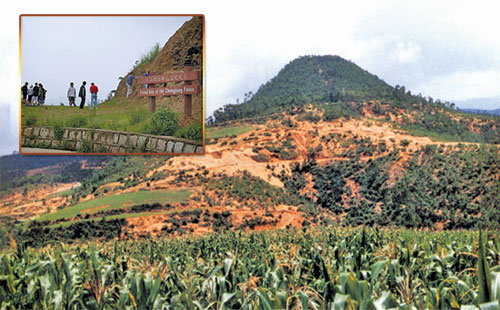
The new Cambrian fossils discovered in China’s Chengjiang region confirmed the Burgess Shale fossils that had been ignored for the past 70 years. With these new fossils, the number of Cambrian phyla rose still further, and it was realized that these organisms had existed all across the globe.
The fossils discovered in Chengjiang confirm the wondrous variety of Cambrian life forms. And as Valentine stated, there are no signs of any intermediate forms. Not one single intermediate fossil, of the kind so confidently expected by evolutionists, showing that one species evolved from one another, has ever been found from among tens of thousands of fossils. Because evolution never happened on Earth, it is therefore impossible for non-existent intermediates to be found. The Chengjiang discoveries were of particular importance because as we have just seen, the perfectly preserved Burgess Shale fossils were ignored for some 70 years. Dr. Paul Chien says:
[Against the fossils found in Chengjiang,] the scientists come out and say, “Oh yes, we’ve heard this before, and it’s very similar to the Burgess Shale,” and so forth. But the Burgess Shale story was not told for many years. The Burgess Shale was first found by Charles Walcott in 1909. Why was the story not reported to the public until the late 1980s?
At the very beginning, I thought it was a problem for them; they couldn’t figure out what was going on because they found something that bears no resemblance to the present animal groups and phyla. Walcott originally tried to shoehorn those groups into existing ones, but [his attempt] was never satisfactory.

Dr. Paul Chien
It was puzzling for a while because they refused to see that in the beginning there could be more complexity than we have now. What they are seeing are phyla that do not exist now. That’s more than 50 phyla compared to the 38 we have now. (Actually, the number 50 was first quoted as over 100 for a while, but then the consensus became 50-plus.) But the point is, they saw something they didn’t know what to do with; that’s the scientifically honest position they’re placed in. Later on, as they began to understand things are not the same as Darwinian expectations, they started shutting up.62
Dr. Chien is making clear that for 70 years, evolutionist scientists made an effort to conceal this extraordinary discovery that challenges evolution. They attempted to cover up the fact that evolution never happened and tried to ignore one of the greatest discoveries in the history of paleontology.
However, the Cambrian fossils were so widespread, and there were so many specimens of them, that it was impossible for them all to be kept out of sight. Over the next century or so, evolutionists did all they could to depict the phenomenon as insignificant, but finally had to admit the inescapable truth. At a time when, according to them, there should have been no complex life forms, representatives of present-day and other phyla existed and survived for centuries, until some disappeared as suddenly as they had emerged.
There was no evolution in their past, nor any in their subsequent periods. The fact that evolutionist scientists remained silent and never performed any detailed research on this subject once again demonstrates that the claim they espouse is unscientific, and based upon completely false grounds.
In the Blink of an Eye
The Cambrian—between 543 and 490 million years ago—was regarded as the period during which Cambrian life forms appeared. However, the more fossils were studied, the more it became clear that these species came into being over a much shorter period.
At first, scientists had imagined that Cambrian life forms existed over a period of some 70 million years. Estimates based on the mineral zircon in Early Cambrian fauna proved, however, that this explosion lasted for only around 5 million years, and certainly no longer than 10 million.
This calculation was explained in an article published in Time in 1995:
Zircon dating, which calculates a fossil’s age by measuring the relative amounts of uranium and lead within the crystals, had been whittling away at the Cambrian for some time. By 1990, for example, new dates obtained from early Cambrian sites around the world were telescoping the start of biology’s Big Bang from 600 million years ago to less than 560 million years ago. Now, with information based on the lead content of zircons from Siberia, virtually everyone agrees that the Cambrian started almost exactly 543 million years ago and, even more startling, that all but one of the phyla in the fossil record appeared within the first 5 million to 10 million years.63
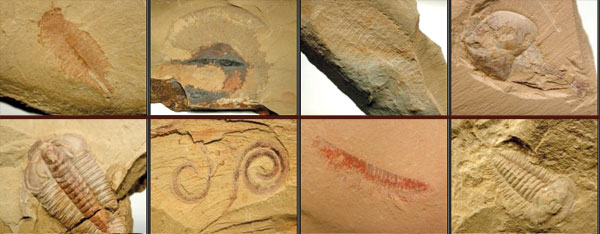
The Cambrian fossils discovered in the Chengjiang region of China clearly reveal that complex life forms, no different from those living today, existed some 530 million years ago.
In geological terms, 5 million years is no more than the blink of an eye. This brief period made the fictitious process of evolution, already invalid in so many respects, totally impossible. This added the problem of an inexplicable time frame to that of the inexplicable variety of life that evolutionists were already unable to explain.
In an interview for Time, Samuel Bowring from M.I.T. said:
We now know how fast fast is. . . . And what I like to ask my biologist friends is, How fast can evolution get before they start feeling uncomfortable?64
This is an astonishingly short space of time for some 50 separate phyla and a variety of species—part of which is known to us and part is not—to suddenly emerge with no warning.
Compared with a human being’s life span, 5 million years is certainly a long time. Yet the time frame needed for the fictitious stages that evolutionists claim would allow organisms to diverge and acquire complex characteristics is millions or even billions of years long. Bearing in mind that the Earth is now regarded as being 4.6 billion years old, 5 million years represents just 0.001 of the total age of the Earth, and in relative terms, is just a single instant.65
Jonathan Wells describes this rather brief period this way:
The major increase in animal fossils that marks the Cambrian explosion began about 530 million years ago, and lasted a maximum of 5 to 10 million years. (Although 10 million years is a long time in human terms, it is short in geological terms, amounting to less than 2 percent of the time elapsed since the beginning of the Cambrian.)66
Stephen Jay Gould also commented on this extraordinary speed:
Fast is now a lot faster than we thought, and that is extraordinarily interesting.67
In an article published in Scientific American, Gould described the truth about the Cambrian’s 5-million-year “window” that all evolutionists have had to accept:
Even the most cautious opinion holds that 500 million subsequent years of opportunity have not expanded the Cambrian range, achieved in just five million years. The Cambrian explosion was the most remarkable and puzzling event in the history of life.68
In addition to the complex features of the organisms that suddenly appear in Cambrian rocks, evolutionists must also explain how these creatures came into being in a space of time too short for the lengthy stages of the supposed evolutionary process to have taken place. In as short a space of time as 0.001 of the age of the Earth, could imaginary evolutionary stages have given rise to thousands of creatures, prey and predator, with various and different features, hard shells, perfect eyes and circulatory and digestive systems, in an environment that formerly held only a few, small multi-celled organisms? How might this imaginary process have worked and overcome so many impossibilities? That new life forms emerged in such a short space of time shows that evolution contradicts its own thesis.
| The kingdom of the heavens and the Earth and everything in them belongs to Allah. He has power over all things. |
As you shall see in a later chapter, evolutionists have attempted to explain this extraordinarily short period of time in various ways, although no account has been at all consistent with the facts.
Here, it will be useful to emphasize that though the various Cambrian life forms appeared within 5 million years, each individual species must have been created at a different time, but in a single moment over those 5 million years. There has been no evolutionary process in this 5-million-year period, just as there has been none in any stage in the history of life.
Allah created these living things for that limited period in history alone, brought them into being from nothing, and did away with them at a moment of His choosing. Indeed, each of the categories that appeared subsequently within the Cambrian phyla did so not by descending from one another. The fossil record makes this crystal-clear. No fossil remains point to an evolutionary relationship among them.
The well-known evolutionist paleontologist George G. Simpson admits as much:
[Paleontologists recognize] that most new species, genera and families, and that nearly all categories above the level of families, appear in the record suddenly and are not led up to by known, gradual, completely continuous transitional sequences.69
In the same way that new species appeared suddenly, they also preserved all their own characteristics and remained completely unchanged, throughout their time on Earth. That is why Gould has written that after the Cambrian almost nothing happened:
The Burgess Shale teaches us that, for the history of basic anatomical designs, almost everything happened in the geological moment just before, and almost nothing in more than 500 million years since."70
The post-Cambrian fossil record, as summarized above by Simpson and Gould, clearly conflicts with the Darwinist idea of gradual development and reveals the two characteristics of sudden appearance and stasis. Gould has explained these two concepts:
The history of most fossil species includes two features particularly inconsistent with gradualism:
- Stasis. Most species exhibit no directional change during their tenure on earth. They appear in the fossil record looking much the same as when they disappear; morphological change is usually limited and directionless.
- Sudden appearance. In any local area, a species does not arise gradually by the steady transformation of its ancestors; it appears all at once and `fully formed.71
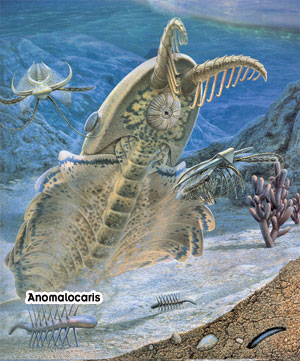 In the post-Cambrian period, in short, there was no increase in anatomical variety at the phylum level. The categories that emerged subsequently consisted of repetitions of already existing basic body structures. Like the phyla, these new categories also emerged suddenly, complete with perfect structures. And they, too, underwent no evolutionary changes during their time on Earth, but maintained their physical characteristics for millions of years, exhibiting obvious stasis.
In the post-Cambrian period, in short, there was no increase in anatomical variety at the phylum level. The categories that emerged subsequently consisted of repetitions of already existing basic body structures. Like the phyla, these new categories also emerged suddenly, complete with perfect structures. And they, too, underwent no evolutionary changes during their time on Earth, but maintained their physical characteristics for millions of years, exhibiting obvious stasis.
The emergence of Cambrian life forms with all their variety and complexity, across the globe and in a single moment, represents the clearest and absolute refutation of any evolution-based explanation of the origin of living things. Evolutionists have invalidated their own claims by means of the “gradual evolutionary development” thesis they have themselves imposed. There was no gradual development in the Cambrian, much less enough time for one to have taken place. Literally dozens of organisms appeared in a short period of time, each one in a fully formed, advanced state.
Allah created a miracle that would eventually demolish Darwinist claims, and act as a lesson to those looking for explanations other than Allah’s creation leaving them with no alternative account to offer. The remains we see in the Cambrian strata are marvelous works of living art—the flawless work of Almighty Allah, and a manifestation of His omniscience and might.
In the creation of the heavens and Earth, and the alternation of the night and day, and the ships which sail the seas to people’s benefit, and the water which Allah sends down from the sky—by which He brings the Earth to life when it was dead and scatters about in it creatures of every kind—and the varying direction of the winds, and the clouds subservient between heaven and Earth, there are signs for people who use their intellect. (Surat al-Baqara, 164)
DİPNOTLAR
41- Stephen Jay Gould, The Book of Life: The Burgess Shale and the Nature of History, W. W. Norton & Company Inc., 2001, s. 52![]()
42- Andrew Parker, In The Blink of an Eye, Perseus Publishing, April 2003, s. 6![]()
43- Pierre P. Grassé, Evolution of Living Organisms, Academic Press, New York, 1977, s. 82![]()
44- http://www.leaderu.com/orgs/probe/docs/bigbang.html![]()
45- Andrew Parker, In The Blink of an Eye, Perseus Publishing, April 2003, s. 30![]()
46- Gerald Schroeder, “Evolution: Rationality vs. Randomness”, http://www.geraldschroeder.com/evolution.html![]()
47- http://www.learnthebible.org/creation_science_cambrian_explosion_disproves_evolution.htm![]()
48- http://www.palaeos.com/Paleozoic/Cambrian/Cambrian.htm![]()
49- Richard Monastersky, “The first monsters: long before sharks, Anomalocaris ruled the seas - oldest known large predators”, Science News, 27 Ağustos1994 ![]()
50- Richard A. Kerr, “A Trigger for the Cambrian Explosion?”, Science, 298, 22 Kasım 2002, 1547![]()
51- Ernst Mayr, This is Biology “The Science of the Living World”, The Belknap Press of Harvard University Press, 1997, s. 196![]()
52- Stephen Jay Gould, Wonderful Life: The Burgess Shale and the Nature of History, Penguin: Londra, 1991, s. 46-47![]()
53- Stephen Jay Gould, The Book of Life: The Burgess Shale and the Nature of History, W. W. Norton & Company Inc., 2001, s. 51![]()
54- Richard Monestarsky, “Mysteries of the Orient”, Discover, Nisan 1993, s. 40 ![]()
55- http://bevets.com/equotesd2.htm - Richard Dawkins, The Blind Watchmaker, London, W. W. Norton, 1986, s. 229![]()
56- http://www.arn.org/docs/abstasis.htm![]()
57- Simon Conway Morris, The Crucible Creation The Burgess Shale and the Rise of Animals, Oxford University Press, 1999, s. 171![]()
58- Dr. Jonathan Wells, “Evrim mi, Mit mi?” Evrimin İkonları, Gelenek Yayıncılık, 2003, s. 48-49![]()
59- http://www.origins.org/articles/chien_explosionoflife.html![]()
60- http://www.abc.net.au/rn/science/ss/stories/s1375551.htm![]()
61- Duane T. Gish, The Evolution: The Fossils Still Say No!, Institude of Creation Research, California, 1985, s. 58![]()
62- http://www.origins.org/articles/chien_explosionoflife.html![]()
63- Nash, J. Madeleine, “When Life Exploded”, Time, 4 Aralık 1995, s. 74. http://www.time.com/time/magazine/archive/1995/951204/cover.html![]()
64- http://www.angelfire.com/tn/tifni/misc/cambrianexplosion.html![]()
65- Walter Starkey, The Cambrian Explosion, Evolution’s Big Bang? Or Darwin’s Dillema?, WLS Publishing, 1999, s. 281![]()
66- Jonathan Wells, Evrim mi, Mit mi? Evrimin İkonları, Gelenek Yayıncılık, 2003, s. 49 ![]()
67- http://www.leaderu.com/orgs/probe/docs/bigbang.html![]()
68- Stephen Jay Gould, “The Evolution of Life on the Earth”, Scientific American, Ekim 1994, s. 67![]()
69- George G. Simpson, The Major Features of Evolution, s. 360.![]()
70- Stephen Jay Gould, (1988), “A Web of Tales”, Natural History, Ekim 1988, s. 16-23 ![]()
71- Stephen J. Gould, "Evolution's Erratic Pace," Natural History, Sayı 86, No. 5, Mayıs 1977, s.14 - http://members.iinet.net.au/~sejones/fsslrc02.html ![]()
